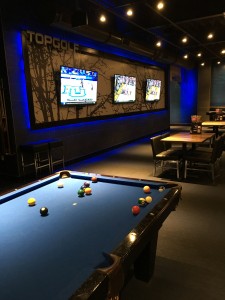Salley, Kim. “Preventing Shelternization: Alleviating The Struggles Of Homeless Individuals And Families In New York City.” Fordham Urban Law Journal 42.4 (2015): 1019-1062. Academic Search Complete. Web. 3 Feb. 2016.
In the article, “Preventing Shelternization: Alleviating The Struggles Of Homeless Individuals And Families In New York City”, author, Kim Salley, discusses the problems that the homeless man and women of New York City face. While the article has several points and is broken up into four sections that also contain sub-sections, I am primarily focusing on the second section titled: “Sate of the Homeless: Factors Contributing to Homelessness and Failed Legislative Policies. Upon acknowledging the growing homeless population and a lack of preventative measures, Salley sought to provide New York with potential solutions to the problem, such as implementing more preventative programs, closing the gap between the minimum wage and the housing wage and establishing a better public assistance to help them get health care and food. Although the article discusses the struggles facing homeless individuals in New York City and my research topic is Downtown, Atlanta, it is still a reputable source because it was acquired through Georgia State University’s library database. Additionally, both places are popular urban cities and it is possible that some of those problems may also be applicable to the homeless population in Atlanta.
Sparks, Sarah D. “Homeless Student Population Still Rising.” Education Week 33.11 (2013): 1-15. MasterFILE Elite. Web. 3 Feb. 2016.
In the article, “Homeless Student Population Still Rising”, author, Sarah Sparks, discusses how the 2008 recession in the United States has impacted the homeless student population. Sparks considers the factors that contribute to the problem, such as the recession itself, a lack of shelter, children being displaced and family need being unmet. In the shelter section, Sparks talks about how these students often have nowhere to go for shelter because the families that would have taken them in were struggling themselves and could not afford to take in anyone else. The section titled “Reasons for Leaving” points out the circumstances encouraging the students to leave such as domestic violence, problems in at home. Another section about family needs labeled transportation as a huge problem for the homeless students. Without transportation, they are unable to get to and from work, which makes it difficult for them to meet their needs. They could not make enough money to pay for transportation, food, shelter, and their education. Due to the fact that Sparks discusses the United States as a whole instead of just one location, the article is applicable to my research topic of Downtown, Atlanta. Given that I got the article through Georgia State University’s library database and Sparks uses statistics to back up her claim that the homeless student population is still rising, I consider it to be reputable source.
“It’s drugs that make people live on streets.” Daily Mail 18 Dec. 2014: 39. Regional Business News. Web. 3 Feb. 2016.
In this news article from Daily Mail titled “It’s drugs that make people live on streets” by Regional Business News, the author claims that the homeless population faces homelessness due to drug addiction. The author acknowledges that there is a need for more affordable housing; however, he believes that no matter how many houses are built, the homeless population will still exist due to the number of homeless men and women who are addicts. He, the author, also points out the problem as predominantly one of the urban areas. The author concludes by stating, “as long as we fail to acknowledge that heroin is still eating away at the very heart of our society, not only will homelessness continue to grow, but it will be the least of our problems” (Daily Mail). This article came from the Georgia State University library database, which provides it with a little bit of credibility, but not entirely. The article fails to recognize the numerous factors other than drugs and affordable housing that also contribute to homelessness. It also labels many of the people on the streets as drug addicts, which discredit those who are on the streets and not on drugs. This article acts as an example for how people often look down on the homeless population, which makes it harder for them to progress.
Childress, Sarah, et al. “Mental Illness And Substance Use Problems In Relation To Homelessness Onset.” American Journal Of Health Behavior 39.4 (2015): 549-555 7p. CINAHL Plus with Full Text. Web. 23 Feb. 2016.
In the article, “Mental Illness and Substance Use Problems In Relations To Homelessness Onset”, author, Sarah Childress discusses the association between mental illness, substance use, and homelessness. Childress Childress’ article studied 394 homeless adults and gathered a plethora of statistical evidence to establish a relationship. The study took place in Dallas, Texas and was comprised of random homeless men and women who saw the flyers and wanted to participate. However, the criteria they were required to meet were that they must be at least 18 years old, English-speaking, and have a 7th grade literacy level. Of the participants that Childress studied, 124 of them reported you-onset homelessness. The homeless youth reported “using substances to attenuate the negative psychological effects of living on the streets, to reduce depressive symptoms, and to stay awake when they experience difficulty finding a safe place to sleep” (Childress, 550). A problem that Childress remarked was how the youth tend to be less likely to seek help, thus face the same or worsened drug and psychological problems into adulthood. Based on the mental illness related statistics that Childress obtained, “64.7% of the sample reported a major depression diagnosis, 41.1% a bipolar disorder diagnosis, and 25.4% schizophrenia or a schizoaffective disorder diagnosis at some point over the lifetime” (Childress, 551). Similarly, the statistics for self-reported problematic substance use were also high. The purpose of Childress’ article was to see if there was in fact a relationship between mental illness, substance use, and homelessness. While I feel as though the article provided substantial statistical evidence to support the relationship, it failed to compare mental illness and drug use to people who are not homeless; thus their homelessness may be unrelated.
Bruce, Douglas, et al. “Modeling Minority Stress Effects On Homelessness And Health Disparities Among Young Men Who Have Sex With Men.” Journal Of Urban Health 91.3 (2014): 568-580 13p. CINAHL Plus with Full Text. Web. 23 Feb. 2016.
Throughout the article, “Modeling Minority Stress Effects On Homelessness And Health Disparities Among Young Men Who Have Sex With Men”, author Douglas Bruce explores the relationship between sexuality and homelessness amongst adolescents. Based on extensive research, Bruce claims that homosexual youth are more likely to experience homelessness than heterosexual youth. The minority stress theory is also discussed in the article and believes that the “transitional period between adolescence and adulthood may be reshaped by experiencing homelessness or being kicked out of one’s parental home”(Bruce, 568). As a result, the physical and mental health of the adolescents is impaired, which may make it more difficult for them to escape homelessness, as they grow older. Bruce studied 200 young men who have sex with men in an effort to identify the association between sexuality, drug use, and homelessness. He found that the young men who are homosexual and got kicked out of the house had a higher rate of homelessness and daily marijuana use. The article proved the correlation between sexuality and homelessness.
CBS 46. “Police Warn Homeless Campers of Eviction from Woodruff Park – CBS46 News.” April 10, 2012. Accessed February 5, 2016. http://www.cbs46.com/story/17378825/police-warn-homeless-campers-of-eviction-from-woodruff-park.
In the news article, “Police Warn Homeless Campers of Eviction from Woodruff Park”, y CBS 46, the dozens of homeless men and women camping in the park are being told that they could not stay there. The article is accompanied by an image of the homeless campers and their tents lining the sidewalk and a couple a police officers standing in front of them. The tents were left in the park after “hundreds of demonstrators camped out for weeks inside the park to protest corporate greed, foreclosures, and wars in the Middle East” CBS 46). However, when they left, the homeless began occupying the tents and living out of them. In response to being asked if alternative shelter was offered to the homeless, Atlanta Police Department Deputy Chief, Renee Propes, said “Absolutely. The United Way was out here. They have transitional housing they can connect these folks too” (CBS 46). Conversely, some of the homeless people, such as Irvin Perrisseaud, feel as though the shelters are dangerous. Without warning or a specific timeframe, they were told to pack up their “homes” and told that they had to leave due to the new ordinance outlawing having tents on the sidewalks and living out of them. Given that man of the homeless men and women are mentally ill or haw drug and alcohol problems, they should probably be helped rather than evicted and told to move. This article provides an example of homelessness in downtown Atlanta, as well as how they are often displaced.
Sanburn, Josh. “The Radically Simple Solution To Homelessness.” Time 187.9 (2016): 19-20. Academic Search Complete. Web. 23 Mar. 2016.
In the New York Times’ article titled “The Radically Simple Solution to Homelessness, the author Josh Sanburn proposed that the problem of homelessness is not as difficult to solve as many people make it out to be. Sanburn acknowledged psychologist Sam Tsemberis’ plan to reverse they way the issue of homelessness way approached. Initially, the U.S. tackled homelessness by first addressing the mental illnesses and substance abuse conflict that was hindering the homeless population from acquiring and maintaining shelter rather than providing them with places to live first. Tsemberis believed that “once people had housing, more often than not, they kept it” (Sanburn, 19). After years of testing Tsemberis’ plan, the “housing first” approach proved itself to be a success. However, Sanburn went on to recognize how much more difficult it is to find permanent housing for increasingly high numbers of homeless people in populous urban areas, such as New York City. In order to get and maintain housing in those areas the issues of safety, health, and budget must be addressed first. In response to the budget problem in Los Angeles, “the council on Feb. 9 approved a $1.85 billion plan that embraces a housing-first approach” (Sanburn, 20). Regardless of the problems that the housing first plan has encountered, Sanburn believes that is shows tremendous promise. This article was publish barely a week ago and addresses the issue of homelessness not only in New York, but also in other highly populated cities, such as Chicago and Los Angeles. With the proper funding, leadership and safety measures, a similar approach could be taken to decrease the homeless population in Atlanta, as well.
Reed, Mayor Kasim. “Atlanta Reduces Homeless Population (and Saves Money in the Process).” CNNMoney, December 11, 2014. http://money.cnn.com/2014/12/11/news/economy/atlanta-kasim-reed-innovation/index.html.
In the CNN article “Atlanta Reduces Homeless Populations (and Saves Money in the Process), Mayor Kasim Reed discusses the innovative ways in which the city of Atlanta partnered with City Hall, local communities, and the private sector to address the one of Atlanta’s major problems, homelessness. Atlanta’s innovation team sought to reduce the number of people who were homeless or in emergency shelters. In 2011, Reed reported that there were ”approximately 4,400 people” of that status (Reed). The team researched the reasons behind the homelessness and with that information, they launched the campaign Unsheltered No More. Unsheltered No More teamed up with over 51 partners with the goal “to house 800 homeless by December 2013” (Reed). By that time, the team exceeded its goal and housed over 1,000 persons. Reed believes that with the help of partnerships and adequate funding, the city can be transformed and the homeless population can be helped. Reed quoted one of his favorite African proverbs to describe the situation- “if you want to go fast, go alone; if you want to go far, go with others”.
Flanagan, Mark W., and Harold E. Briggs. “Substance Abuse Recovery Among Homeless Adults In Atlanta, Georgia, And A Multilevel Drug Abuse Resiliency Tool.” Best Practice In Mental Health12.1 (2016): 89-109. Academic Search Complete. Web. 25 Mar. 2016.
In the article “Substance Abuse Recovery among Homeless Adults in Atlanta, Georgia, and a Multilevel Drug Abuse Resiliency Tool” by Flanagan and Briggs, the authors describe homeless with addictions and try to give insight into the strain put on them when trying to escape their poverty. The writing first gives background into the nature of homelessness involving drug use and the stigma that is perpetuated by this. It is often looked down upon as a criminal act instead of a mental and clinical illness. By treating these individuals as criminals, they are forced into staying homeless. They have no opportunity to turn their life around, because they don’t have the resources to do so. In Atlanta, these conditions are consistently encountered. Atlanta has the seventh largest homeless population in the country, and it is fifth on the list when it comes to the chronically homeless. With this level of drug use and homelessness combined, there is an intense structural violence and sociological weight on the individuals. The authors describe this as “large-scale forces—ranging from gender inequality and racism to poverty”(Flanagan and Briggs). They also state the fact that to really help these people, each cause of their conditions has to be addressed individually. “Drug abuse is both a symptom and cause of homelessness that generally hinders homeless persons from making positive changes in their lives” (Flanagan and Briggs).
Marcil, Tiffany, et al. “Homeless Inmates Statistics For Orange County Corrections In Florida.” Corrections Today 78.1 (2016): 16-19. MasterFILE Elite. Web. 25 Mar. 2016.
In the article, “Homeless Inmates Statistics for Orange County Corrections in Florida”, the authors first describe the statistics behind homeless inmates in the Orange County system. They discovered that around ten percent of the inmates per a day were homeless. Of all the homeless in the county, around 24 percent were in the jails. There are almost no resources for these individuals once released so most are repeat offenders. In fact, “Close to 70 percent of youths in the juvenile justice system have a diagnosed mental health disorder, and approximately 30 percent suffer from a mental illness so severe it impairs their ability to function as a responsible adult” (Marcil, 24). The authors then describe The Value of Alternative Therapies In Mental Health Treatment for Incarcerated Youths. The importance being that this can prevent these kids from being in and out of homes or jails. Instead they have a chance to actually turn their lives in a different direction. It also saves the state a tremendous amount of money both short term and in the long run. Starting young can make a huge impact.






